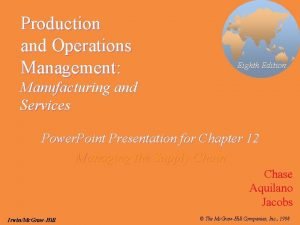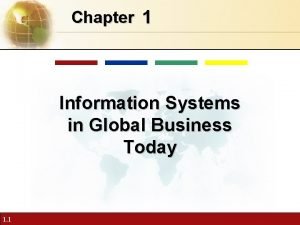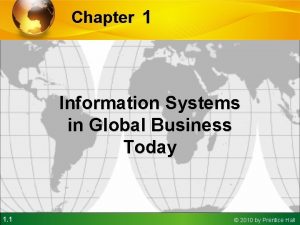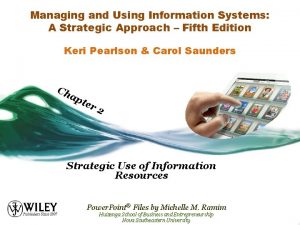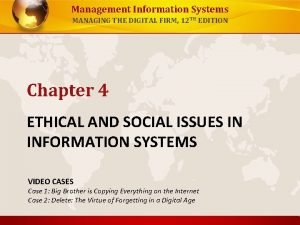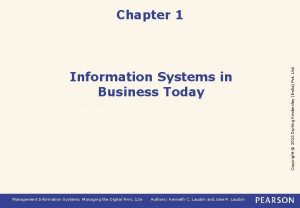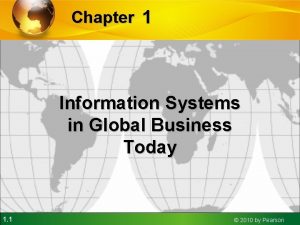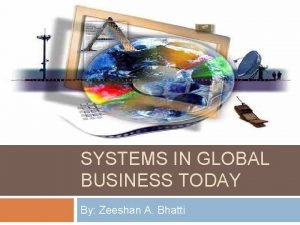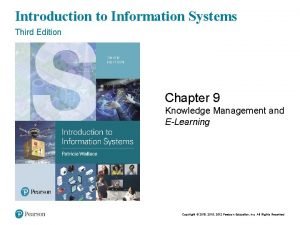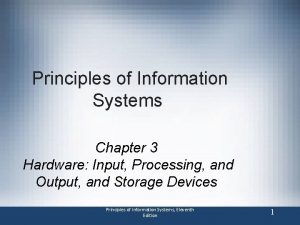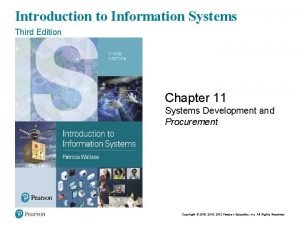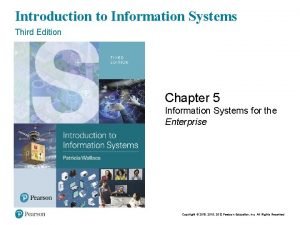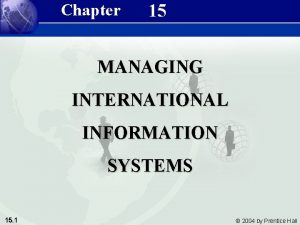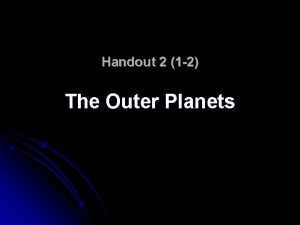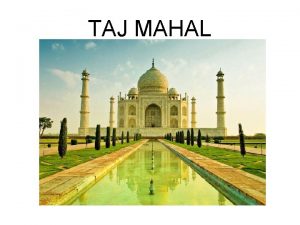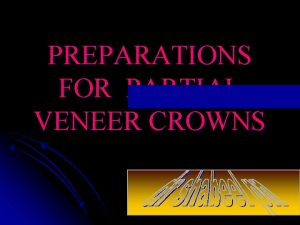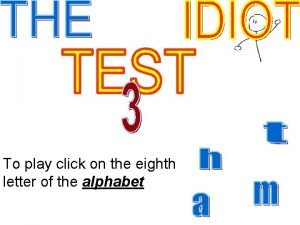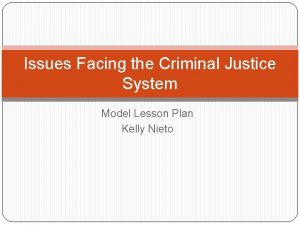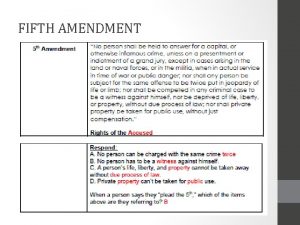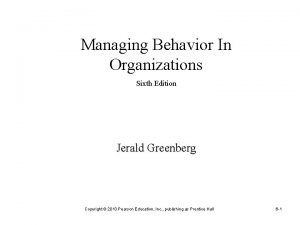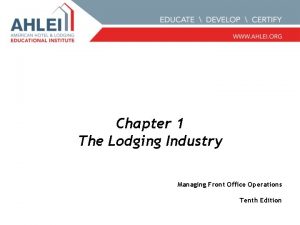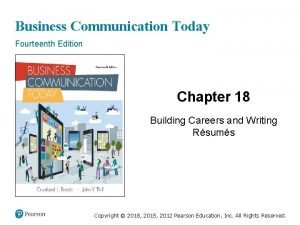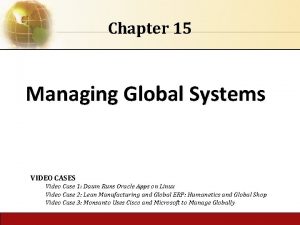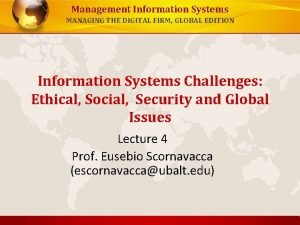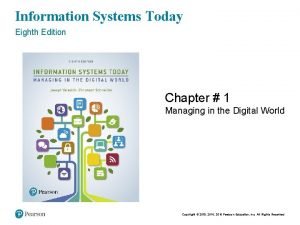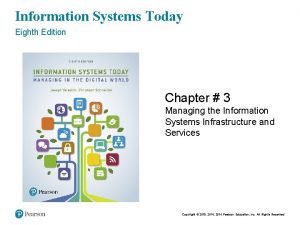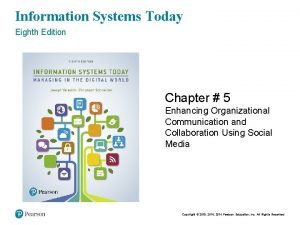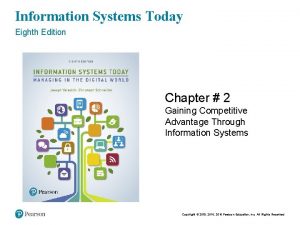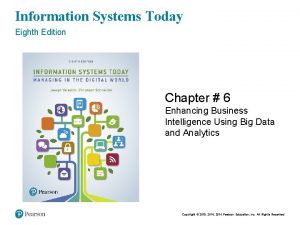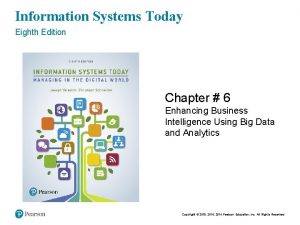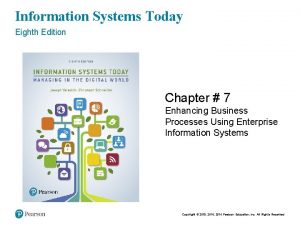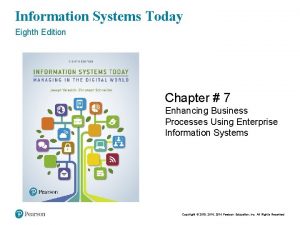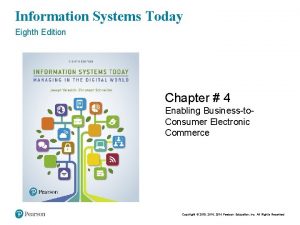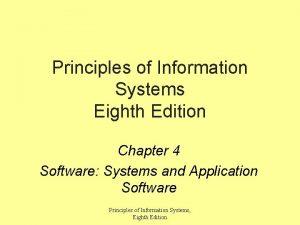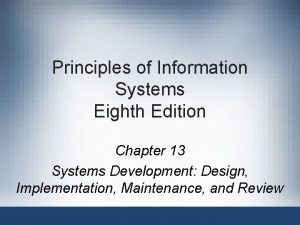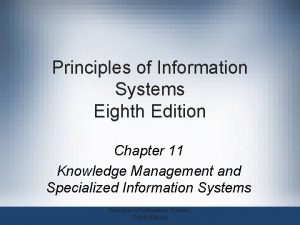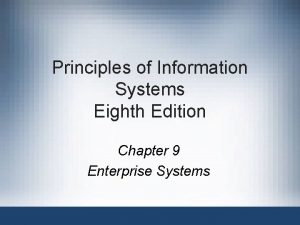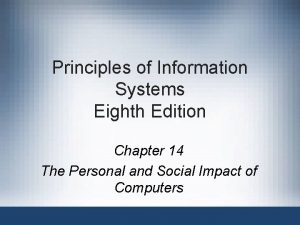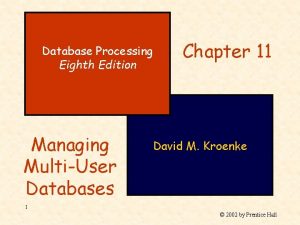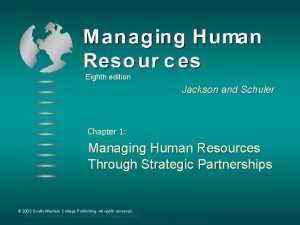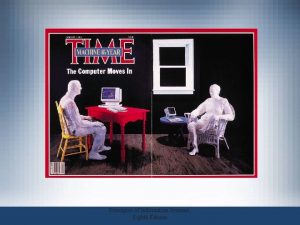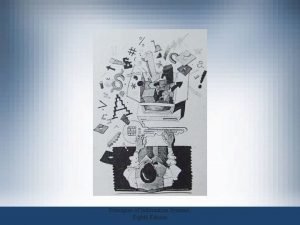Information Systems Today Eighth Edition Chapter 3 Managing



















































- Slides: 51

Information Systems Today Eighth Edition Chapter # 3 Managing the Information Systems Infrastructure and Services Copyright © 2018, 2016, 2014 Pearson Education, Inc. All Rights Reserved

Learning Objectives • • 3. 1 Describe how changes in businesses’ competitive landscape influence changing IS infrastructure needs. 3. 2 Describe the essential components of an organization’s IS infrastructure. 3. 3 Discuss managerial issues associated with managing an organization’s IS infrastructure. 3. 4 Describe cloud computing and other current tends that can help an organizational address IS infrastructure-related challenges. Copyright © 2018, 2016, 2014 Pearson Education, Inc. All Rights Reserved

The IS Infrastructure (1 of 2) • Learning Objective: Describe how changes in businesses’ competitive landscape influence changing IS Infrastructure needs. • Applications and Databases Supporting Processes Copyright © 2018, 2016, 2014 Pearson Education, Inc. All Rights Reserved

The IS Infrastructure (2 of 2) • Businesses rely on an information systems infrastructure – – – Hardware System software Storage Networking Data centers Copyright © 2018, 2016, 2014 Pearson Education, Inc. All Rights Reserved

Applications and Databases Supporting Business Process • Application Software – Software Tools § Process automation § Decision support § Other business and user needs • Databases – Collections of data – Organized to facilitate data searches Copyright © 2018, 2016, 2014 Pearson Education, Inc. All Rights Reserved

IS Infrastructure Components • Learning Objective: Describe the essential components of an organization’s IS infrastructure. • Hardware • System Software • Storage • Networking • Data Centers Copyright © 2018, 2016, 2014 Pearson Education, Inc. All Rights Reserved

IS Infrastructure Components: Hardware. Computer Types (Table 3. 1) Type of Computer Number of Simultaneo us Users Physical Size Typical Use Random Access Memory Typical Cost (in US$) Supercomputer One to many Like an automobile to as large as multiple rooms Scientific research 5, 000+ GB Up to $100 million Mainframe 1, 000+ Like a refrigerator Transaction processing, enterprise-wide applications Up to 3, 000 GB Up to $10 million Server 10, 000+ Like a DVD player and mounted in a rack to fitting on a desktop Providing websites or access to databases, applications or files Up to 512 GB Up to $50, 000 Workstation Typically one Fitting on a desktop to the size of a file cabinet Engineering, medical, graphic design Up to 512 GB Up to $100, 000 Personal computer One Fitting on a desktop Personal productivity 512 MB to 32 GB Up to $5, 000 Mobile device One Handheld Personal productivity 512 MB to 2 GB Up to $750 Copyright © 2018, 2016, 2014 Pearson Education, Inc. All Rights Reserved

IS Infrastructure Components: System Software • Controls computer hardware operations • Operating systems – Examples: Windows, OS X, Ubuntu, Linux – Manages hard drives and storage – Manages keyboard, mouse, monitor, and printers – Coordinates application access to computing resources Copyright © 2018, 2016, 2014 Pearson Education, Inc. All Rights Reserved

IS Infrastructure Components: Storage Type Purpose Operational For processing transactions or for data analysis Backup Short-term copies of organizational data, used to recover from system related disaster (Backup data are frequently overwritten with newer backups Archival data Long-term copies of organizational data, often used for compliance and reporting purposes Copyright © 2018, 2016, 2014 Pearson Education, Inc. All Rights Reserved

IS Infrastructure Components: Networking • Both human and computer communication involve senders, a message to share, and receivers. Network requires: • Sender and receiver • Transmission pathway • Rules/protocols for communication Copyright © 2018, 2016, 2014 Pearson Education, Inc. All Rights Reserved

IS Infrastructure Components: Servers, Clients, and Peers • Servers – Host (serve up) data, databases, files applications, Web sites, video, and other content for access over the network • Clients – Consume hosted resources • Peers (P 2 P) – Serve and consume resources, both a server and a client interacting with similar computers Copyright © 2018, 2016, 2014 Pearson Education, Inc. All Rights Reserved

IS Infrastructure Components: Types of Networks Type Usage Size Personal area network (PAN) Wireless communication between devices (Bluetooth) Under 10 meters Local area network (LAN) Sharing of data, software applications, or other resources between several users Typically within a building Wide area network (WAN) Connect multiple LANs, often with distributed ownership and management Large physical distance spanning multiple buildings or the area of a city to worldwide (Internet) Copyright © 2018, 2016, 2014 Pearson Education, Inc. All Rights Reserved

The Internet and the World Wide Web (WWW) • The Internet is a large worldwide collection of networks that use a common protocol to communicate with each other – The Internet is based on internetworking, or combining networks to form larger networks • The World Wide Web is a system of interlinked documents on the Internet – – Web protocols (e. g. , HTML and HTTP) Web pages (documents containing HTML) Web servers (provides access via a Web site) Web browsers (provides interface to Web pages) Copyright © 2018, 2016, 2014 Pearson Education, Inc. All Rights Reserved

Web Domain Names and Addresses • Uniform Resource Locator (URL) is used to identify and locate a particular Web page • Domain name is a term that helps people recognize the company or person – Prefix, like “google” or “Microsoft” – Suffix, like. com, . edu, . org, . gov, or two-letter country codes Copyright © 2018, 2016, 2014 Pearson Education, Inc. All Rights Reserved

IP Addresses • The Internet uses IP addresses – IPV 4: Old style, 32 -bit, running out of addresses – IPV 6: New style, 128 -bit, huge address space • The WWW translates domain names into IP addresses – www. arizona. edu translates to (IPV 4) 128. 196. 134. 37 – A URL could be expressed directly as an IP address, although it’s more common to use it’s related domain name Copyright © 2018, 2016, 2014 Pearson Education, Inc. All Rights Reserved

World Wide Web Architecture • Components – Interconnected Web servers – Utilize Transmission Control Protocol/Internet Protocol (TCP/IP) – Communicate over the Internet § § § Clients request Web page hosted on server Server breaks into packets Packets stream over Internet to client Client reassembles Client can request retransmission of any missing packets Web browser translates Web page into visible output Copyright © 2018, 2016, 2014 Pearson Education, Inc. All Rights Reserved

Extranets and Intranets (1 of 2) • Companies have confidential data • These data still need to be shared on a limited basis – Intranet: password-protected Web site designed for sharing within the company – Extranet: password-protected Web site designed for sharing with select partners • Data and communication are protected via firewalls and virtual private networks (VPNs) Copyright © 2018, 2016, 2014 Pearson Education, Inc. All Rights Reserved

Extranets and Intranets (2 of 2) Intranet architecture Extranet architecture Copyright © 2018, 2016, 2014 Pearson Education, Inc. All Rights Reserved

IS Infrastructure Components: Data Centers • Large amounts of data to be managed • Dedicated space for infrastructure components such as data centers • Data center centralization facilitates – Management – Repairs – Upgrades – Security Copyright © 2018, 2016, 2014 Pearson Education, Inc. All Rights Reserved

Issues Associated with Managing the IS Infrastructure • Learning Objective: Discuss managerial issues associated with managing an organization’s IS infrastructure • Rapid Obsolescence and Shorter IT Cycles • Big Data and Rapidly Increasing Storage Needs • Demand Fluctuations • Increasing Energy Needs Copyright © 2018, 2016, 2014 Pearson Education, Inc. All Rights Reserved

Rapid Obsolescence and Shorter IT Cycles Copyright © 2018, 2016, 2014 Pearson Education, Inc. All Rights Reserved

The Beginning of Computing • 1936 – Zeus Z 1 computer introduced § Mechanical computer § Punch-card based – Business and government information systems § Paper based § Huge rooms full of filing cabinets § Specific information known by few employees Copyright © 2018, 2016, 2014 Pearson Education, Inc. All Rights Reserved

Six Generations of Computing (Table 3. 4) Genera tion Time Period Major Characteristic Events 1 1946 -1958 Vacuum tubes • • Mainframe era begins ENIAC and UNIVAC were developed 2 1958 -1964 Transistors • • Mainframe era expands UNIVAC is updated with transistors 3 0964 -1990 s Integrated Circuits • • • Mainframe era ends, PC era begins IBM 360 with general purpose OS Microprocessor Intel; Microsoft, Apple 4 1990 s-2000 Multiple and low cost PCs • • • PC era ends, Interpersonal era begins High-speed processors and networks High capacity storage, low cost high performance video, audio, and data 5 2000 -2010 Widespread Internet accessibility • Interpersonal era ends, Internetworking begins, Price drops, performance expands 6 2010 -Present Ubiquitous mobile connectivity • Advent of powerful mobile devices, big data, cloud computing, Internet of Things, Social networking Copyright © 2018, 2016, 2014 Pearson Education, Inc. All Rights Reserved

Moore’s Law • Dr. Gordon Moore – Co-founder of Intel – Theorized (correctly) that the number of transistors on a chip would double every two years – Transistors predicted computer power § Computing power would double every two years § Has been relatively accurate to this date § First CPU had 2, 200 transistors § Current CPUs have over 5 billion Copyright © 2018, 2016, 2014 Pearson Education, Inc. All Rights Reserved

IT Cycles and Obsolescence • Powerful computers enable new applications • New applications drive efficiencies • New applications often make old hardware obsolete • Obsolete hardware requires replacement Copyright © 2018, 2016, 2014 Pearson Education, Inc. All Rights Reserved

Big Data and Rapidly Increasing Storage Needs • Firms collect unprecedented levels of data – Business intelligence (Chapter 6) – Legal compliance (e. g. , Sarbanes-Oxley) • Unprecedented levels of data require unprecedented infrastructure capabilities – More storage space, powerful hardware, and database management – Ever-increasing Internet bandwidth – Vicious cycle: enhanced capacity drives new applications, requiring even more capacity Copyright © 2018, 2016, 2014 Pearson Education, Inc. All Rights Reserved

Demand Fluctuations • Many companies face demand fluctuations – Seasonal fluctuations (e. g. , December holidays) – Monthly fluctuations (month-end spikes) • Demand fluctuations create inefficiencies – Some estimate up to 70% of IS capacity only used 20% of the time – IS infrastructure is typically not readily scalable § Changing internal capacity takes time § Cloud computing (next section) may be the answer Copyright © 2018, 2016, 2014 Pearson Education, Inc. All Rights Reserved

Increasing Energy Needs • Computing can require a lot of power – Hardware draws power, which generates heat – Heat requires cooling, which requires more power • Data centers can use large amounts of power – 15 to 17 kilowatts per rack – Large data centers have hundreds of server racks – More power is required for cooling and lost through other inefficiencies Copyright © 2018, 2016, 2014 Pearson Education, Inc. All Rights Reserved

Cloud Computing • Learning Objective: Describe cloud computing and other current trends that can help an organization address IS infrastructure-related challenges. • Managing the Cloud • Advanced Cloud Applications • Green Computing Copyright © 2018, 2016, 2014 Pearson Education, Inc. All Rights Reserved

What Is Cloud Computing? • Cloud Computing is a way to allocate resources much like a utility sells power • Resources are used “ondemand, ” as needed • Customers only pay for what they consume • Resources can be rapidly allocated and reallocated • Consumption becomes an operating expense • % utilization and efficiency increase dramatically Copyright © 2018, 2016, 2014 Pearson Education, Inc. All Rights Reserved

Why Cloud Computing Copyright © 2018, 2016, 2014 Pearson Education, Inc. All Rights Reserved

Cloud Computing Characteristics • On-Demand Self Service • Resource Pooling • Rapid Elasticity • Measured Service • Broad Network Access Copyright © 2018, 2016, 2014 Pearson Education, Inc. All Rights Reserved

Cloud Computing Service Models • Infrastructure as a Service (Iaa. S) • Platform as a Service (Paa. S) • Software as a Service (Saa. S) Copyright © 2018, 2016, 2014 Pearson Education, Inc. All Rights Reserved

Public and Private Clouds Copyright © 2018, 2016, 2014 Pearson Education, Inc. All Rights Reserved

Managing the Cloud • Availability/Reliability • Scalability • Viability • Security, Privacy, and Compliance • Diversity of Offerings • Openness • Costs Copyright © 2018, 2016, 2014 Pearson Education, Inc. All Rights Reserved

Advanced Cloud Applications: Service-Oriented Architecture (SOA) • Services—individual components of business processes – Building blocks • Principles of SOA – Reusability – Interoperability – Componentization Using SOA, multiple applications can invoke services Copyright © 2018, 2016, 2014 Pearson Education, Inc. All Rights Reserved

Advanced Cloud Applications: Grid Computing (1 of 2) • Extremely complex problems need heavy computing power Copyright © 2018, 2016, 2014 Pearson Education, Inc. All Rights Reserved

Advanced Cloud Applications: Grid Computing (2 of 2) • Traditionally handled by supercomputers, but – Supercomputers are very expensive – Even supercomputers may not be able to handle the demand • Grid computing—combine many small, networked computers – Decompose and distribute large complex problems Copyright © 2018, 2016, 2014 Pearson Education, Inc. All Rights Reserved

Advanced Cloud Applications: Content Delivery Networks Content delivery networks store copies of content closer to the end user. Copyright © 2018, 2016, 2014 Pearson Education, Inc. All Rights Reserved

Advanced Cloud Computing: Convergence of Computing and Telecommunications • Voice and data traffic sharing a common network infrastructure – Voice over IP (Vo. IP) IP telephony – Video conferencing over IP Copyright © 2018, 2016, 2014 Pearson Education, Inc. All Rights Reserved

Green Computing • Driving forces – Power bills – Reputation – Culture • Approaches – – – Virtualizing servers Cloud computing Power management software Reduced printing Retiring obsolete hardware responsibly Copyright © 2018, 2016, 2014 Pearson Education, Inc. All Rights Reserved

END OF CHAPTER CONTENT Copyright © 2018, 2016, 2014 Pearson Education, Inc. All Rights Reserved

Managing in the Digital World: From Google to Alphabet • Google more than just a search engine! • Formed a holding company named Alphabet – – Placed 10 companies under this umbrella in 2016 Allows investors to invest in Alphabet or a subsidiary Allows Google to focus on what it does best Alphabet owns: § Boston Dynamics (robotics) § Verily (life sciences company) § Nest Labs (home automation) – One of the largest companies in the world Copyright © 2018, 2016, 2014 Pearson Education, Inc. All Rights Reserved

Who’s Going Mobile: Mobile Payments Are Transforming Developing Countries • Rapidly adopted cell phones and other mobile devices • Transformed whole economies and societies • M-Pesa in Kenya revolutionized mobile technology – Mobile payments have become mainstream – 60% Of Kenyans use mobile payments via cell phones • Transforming society in many developing countries Copyright © 2018, 2016, 2014 Pearson Education, Inc. All Rights Reserved

Ethical Dilemma: Putting People’s Lives Online • Google Street View captures millions of people in the everyday lives – Put online for the world to see – Not all pictures are of things people want online § People in places or with people they don’t want public – Can be very intrusive; can even ruin lives – If pictures can be monetized, do companies have a shareholder duty to do so, regardless of consequences to some individuals Copyright © 2018, 2016, 2014 Pearson Education, Inc. All Rights Reserved

Coming Attractions: Making Death Optional? • Humai is a small research company in Los Angeles that wants to extend lives: – Wants to use AI techniques to record a person’s conversational style, behavior, and thought pattern – When that person dies they then want to freeze the brain using cryonics technology – When available, implant the brain into an artificial body – Embedded brain can then control the artificial body Copyright © 2018, 2016, 2014 Pearson Education, Inc. All Rights Reserved

Green IT: Alphabet Renewables • Alphabet transitioning to renewable energy • Goal = 100% renewable energy by 2025 • A global leader in renewable energy, Alphabet has signed contracts with: – – Duke Energy (51 -megawatt solar project) Sweden project (76 -megawatt wind generation project Chili project (80 -megawatt wind generation project) Kenya ($12 million investment wind generation) • $2 Billion total investment in clean renewables Copyright © 2018, 2016, 2014 Pearson Education, Inc. All Rights Reserved

When Things Go Wrong: Old and Dirty Energy Drives Global Internet Growth • Internet central to all aspects of modern society • By 2018 more than 15 billion devices connected – Will require massive amounts of energy – Coal is a cheap energy source but not clean – Coal provided 41% world’s electrical needs in 2013 • Apple is most aggressive clean energy user (Greenpeace report) • Other clean energy users include Facebook, Google, Amazon, and Microsoft) Copyright © 2018, 2016, 2014 Pearson Education, Inc. All Rights Reserved

Security Matters: Car Hacking • Possibility of hacking into computer code that runs multiple onboard computers in a car • Modern vehicles also have Bluetooth for connectivity • Each system can be exploited by hackers in the future • Technology and vehicle component manufacturers working together to make supply chains more secure and to prevent tampering. Copyright © 2018, 2016, 2014 Pearson Education, Inc. All Rights Reserved

Industry Analysis: Movie Industry • Computers allow studio-quality digital editing at an affordable price – Independent filmmakers can compete • CGI for digital effects (Dreamworks, Universal, Weta Digital, Pixar) • Movies released in digital formats • Movie theaters switching to digital projection systems • Theaters receive movies electronically instead of on reels Copyright © 2018, 2016, 2014 Pearson Education, Inc. All Rights Reserved

Copyright © 2018, 2016, 2014 Pearson Education, Inc. All Rights Reserved
 Psychology eighth edition david g myers
Psychology eighth edition david g myers David g myers psychology 8th edition
David g myers psychology 8th edition Operations management eighth edition
Operations management eighth edition Chapter 1 information systems in global business today
Chapter 1 information systems in global business today Chapter 1 information systems in global business today
Chapter 1 information systems in global business today Managing and using information systems
Managing and using information systems Management information systems managing the digital firm
Management information systems managing the digital firm Survival in information system
Survival in information system Information system in global business today
Information system in global business today Information systems in global business today
Information systems in global business today Information system in global business today
Information system in global business today Introduction to information systems 6th edition
Introduction to information systems 6th edition Fundamentals of information systems 9th edition
Fundamentals of information systems 9th edition Fundamentals of information systems 9th edition
Fundamentals of information systems 9th edition White-collar workers คือ
White-collar workers คือ Management information systems 16th edition
Management information systems 16th edition Introduction to information systems 3rd edition
Introduction to information systems 3rd edition Introduction to management information systems 5th edition
Introduction to management information systems 5th edition Principles of information security, 7th edition
Principles of information security, 7th edition Principles of information systems 11th edition
Principles of information systems 11th edition Fundamentals of information systems 9th edition
Fundamentals of information systems 9th edition Essentials of mis, 13th edition
Essentials of mis, 13th edition Introduction to information systems 3rd edition
Introduction to information systems 3rd edition Fundamentals of information systems 9th edition
Fundamentals of information systems 9th edition Introduction to information systems 3rd edition
Introduction to information systems 3rd edition Managing global systems chapter 15
Managing global systems chapter 15 Anagram of eighth
Anagram of eighth Matching planet rings
Matching planet rings Quarter inch fraction
Quarter inch fraction The fifth, sixth, seventh, and eighth amendments protect *
The fifth, sixth, seventh, and eighth amendments protect * Eighth commandment catholic
Eighth commandment catholic Taj mahal 8th wonder of the world
Taj mahal 8th wonder of the world Partial veneer crown preparation
Partial veneer crown preparation Eighth amendment excessive bail
Eighth amendment excessive bail Eighth letter of the alphabet
Eighth letter of the alphabet Eighth amendment excessive bail
Eighth amendment excessive bail What's the 5th amendment
What's the 5th amendment Today meeting or today's meeting
Today meeting or today's meeting Today there is class
Today there is class Meeting objective
Meeting objective Today lesson or today's lesson
Today lesson or today's lesson Today's lesson or today lesson
Today's lesson or today lesson Example of repitition
Example of repitition Managing behavior in organizations 6th edition
Managing behavior in organizations 6th edition Managing front office operations 10th edition
Managing front office operations 10th edition Business communication today chapter 1
Business communication today chapter 1 Criminology today 7th edition
Criminology today 7th edition Mis chapter 6
Mis chapter 6 Using mis (10th edition) 10th edition
Using mis (10th edition) 10th edition Global systems 1 management
Global systems 1 management Managing global systems
Managing global systems Despite the data glut that marketing managers
Despite the data glut that marketing managers


